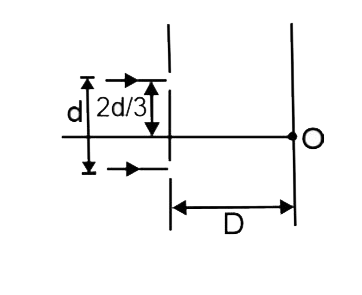In the figure, if a parallel beam of white light is incident on the plane of the slits S1&S2 then the distance of the nearest white spot on the screen from O is dk. Find k [Assume D>>d,d>λ].
'(##CEN_KSR_PHY_JEE_C27_E01_034_Q07##)'
The correct Answer is:3
Topper's Solved these Questions
Similar Questions
In the figure , if a parallel beam of white light is incident on the plane of the slits S1andS2 then the distance of the nearest white spot on the screen from O is [ Assume D>>d,d>>λ ]

View SolutionIn the figure , if a parallel beam of white light is incident on the plane of the slits S1andS2 then the distance of the nearest white spot on the screen from O is [ Assume D>>d,d>>λ ]

View Solution
Knowledge Check
In figure, if a parallel beam of white light is incident on the plane of the slit, then the distance of the nearest white spot on the screen form O is [assume d<<D,λ<<D]
 A0Bd/2Cd/3Dd/6
A0Bd/2Cd/3Dd/6In YDSE,D=1m,d=4mm and λ=12mm in the figure shown, a parallel beam of light is incident on the plane of the slits of YDSE. Light incident on the slit s1, passes through a medium of variable refractive index μ=(2x+1) (where x is the distance from the plane of slits in mm) up to a distance l=1mm before falling on s1. Rest of the space filled with air. Then choose the correct option (s):
 APosition of central brigh fringe is at a distanc y=1√3m above the central lineBPosition of central bright fringe is at a distance y=12m above the central lineCNumber of maxima obtaining on the screening is 7DNumber of maxima obtaining on the screening is 8
APosition of central brigh fringe is at a distanc y=1√3m above the central lineBPosition of central bright fringe is at a distance y=12m above the central lineCNumber of maxima obtaining on the screening is 7DNumber of maxima obtaining on the screening is 8Find the distance between the two parallel straight lines y = mx + c and y = mx + d ? [Assumec>d]
A((c−d)(1+m2)1/2)B((d−c)(1+m2)1/2)C(d(1+m2)1/2)D(−d(1+m2)1/2)
In figure, if a parallel beam of white light is incident on the plane of the slit, then the distance of the nearest white spot on the screen form O is [assume d<<D,λ<<D]

View SolutionIn the figure shown if a parallel beam of white light is incident on the plane of the slits then the distance of the white spot on the screen from O is [Assume <<D,λ<<d]

View SolutionParallel beam is incident on a thin lens and radii 25cm of each of the surfaces as shown. What should be the thickness t of a slab (in cm ) between the lens and the screen so that the final image is formed on the screen?
'(##CEN_KSR_PHY_JEE_C26_E01_036_Q17##)'
View SolutionTwo microwave sources S1 and S2 are located at a distance of 4λ from each other along y -axis, with S1 at the origin as shown in the figure. A microwave detector D moves along the x -axis away from S1. The first maximum is obtained for (x>0) equal to nλ6. Find n. (wavelength of the microwave is λ )
'(##CEN_KSR_PHY_JEE_C27_E01_033_Q06##)'
View SolutionIn the Young's double-slit experiment, the intensity of light at a point on the screen where the path difference is λ is K,(λ being the wave length of light used). The intensity at a point where the path difference is λ4, will be Kn. Find n.
'(##CEN_KSR_PHY_JEE_C27_E01_007_Q01##)'
View Solution
